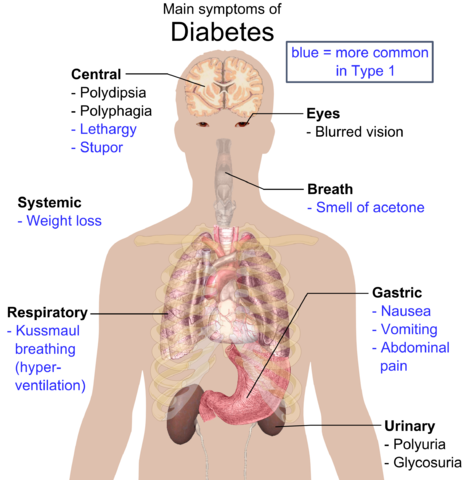Enhance your health with free online physiotherapy exercise lessons and videos about various disease and health condition
Exercises for Diabetics
The article describes the benefits of exercises for diabetics patients. The best and suitable exercises for diabetics patients are demonstrated with aid of videos.
Diabetes is one of the most prevalent lifestyle diseases in modern world but still the awareness about the risks and benefits of exercises to patients with diabetes is limited. There are two distinct types of diabetes mellitus: lnsulin dependent (type 1) and Non insulin dependent (type 2) with distinct challenges associated with exercises.

Insulin dependent diabetes mellitus (IDDM)
It is an inherited autoimmune disease in which antibodies are produced against the beta cells of pancreas. Type 1 diabetes represents approximately 10-15% of the diabetic cases. It is characterized by absence of endogenous insulin production. Therefore insulin administration is essential to prevent ketosis, coma, and death.
Non-Insulin dependent diabetes mellitus (NIDDM)
Read more about Diabetes Here- Diabetes Mellitus
Type 2 diabetes is linked to both genetic and lifestyle factors, It is characterized by diminished insulin secretion relative to serum glucose levels in conjunction with peripheral insulin resistance, both of which result in chronic hyperglycemia. Type 2 diabetes is characterized by three major metabolic abnormalities:
- Impairment in pancreatic beta cell insulin secretion in response to a glucose stimulus.
- Reduced sensitivity to the action of insulin in major organ systems such as muscle, liver and adipose tissue.
- Excessive hepatic glucose production in the basal state.
Exercise and Diabetes
When considering exercise prescription for a diabetic patient target should be to achieve at least 30 minutes of continuous moderate activity (e.g. brisk walking) five or six days a week provided that cardiovascular and hypertensive problems are accounted for.
Both insulin and exercise independently facilitate glucose transport across the mitochondrial membrane and their action is also cumulative, therefore special care must be taken in patients taking insulin. Other points that should be taken care of include:
- Blood sugar levels should be monitored before and after every workout.
- Supplementary glucose may be required in case of extreme heat or strong winds.
- Adequate amount of fluids should be consumed to prevent dehydration.
- Patient should be able to identify signs of hypoglycemia and should carry a source of glucose with them.
Benefits of exercises for diabetics
Exercises for diabetics can significantly reduce the risk of developing Type 2 diabetes. In patients, exercise can help to reduce insulin requirements in two ways. It increases the body’s sensitivity to insulin and it enhances the more efficient utilization of glucose. Exercise helps lower blood sugar levels. Therefore it can help to maintain overall diabetic control.
Type 1 diabetes
|
Type 2 diabetes
|
|
|
Exercise and Type I diabetes (Insulin dependent diabetes mellitus)
It is important to monitor blood sugar levels before, during and after exercise. The meal plan and insulin dosage should be adjusted according to patients response to exercises. The ideal pre exercise blood glucose level is 6.6-10mmol/L (120-180mg/dL). Athletes with blood glucose concentrations exceeding 11mmol/L(200 mg/dL) and ketones in their urine, or blood glucose concentrations exceeding 16.5mmol/L (300mg/dL) regardless of ketone status should postpone exercise and take supplemental insulin. Those with blood glucose level less than 5.5mmol/L (100mg/dL) require a pre exercise carbohydrate snack (e.g. sports drink, juice, glucose tablet, fruit etc.)
Because exercises for diabetics has an insulin-like effect, exercise induced hypoglycemia is the most common problem experienced by exercising diabetics. Hypoglycemia may result when too much insulin is present, or if there is accelerated absorption of insulin from the injection site, which can occur with exercise. Accelerated absorption generally occurs when short-acting insulin is taken and when the injection site is near the active muscles. Hypoglycemia can occur during exercise or up to 4 to 6 hours following an exercise bout. IDDM individuals can reduce the risk of hypoglycemia during acute exercise by taking extra carbohydrates (e.g. glucose sweets) before, and hourly during exercise. IDDM individuals should exercise 1-2 hours after a meal. To avoid the incidence of a hypoglycemic episode it may be necessary to reduce pre-exercise insulin dosages by 30-50%, but this must be carried out under the guidance of a doctor. It is important to monitor blood sugar levels before, during and after exercise.
Exercise and Type II diabetes (Non-insulin dependent diabetes mellitus)
Patients with Type II diabetes who are managed with diet therapy alone do not usually need to make any adjustments for exercise. Those patients taking oral hypoglycaemic drugs may have their doses on the days of prolonged exercises or miss them altogether depending on their glucose levels. Such patients should also carry some glucose with them and should be able to recognize the symptoms of hypoglycemia.
Exercise checklist for people with diabetes
- Talk to your doctor about the right exercise for you, usually aerobic exercises are the best choice.
- Check your blood sugar level before and after exercising.
- Check your feet for blisters or sores before and after exercising.
- Wear the proper shoes and socks.
- Drink plenty of fluid before, during and after exercising.
- Warm up before exercising and cool down afterward.
- Have a snack handy in case your blood sugar level drops too low.
- Do not inject insulin into the muscle groups that will be used during the exercise session because the insulin will be absorbed too quickly, and may result in hypoglycaemia or low blood sugar
- Take extra care when exercising in extreme weather conditions. Hot weather can speed up insulin absorption, while cold weather can slow down insulin absorption.
Return from exercises for Diabetics to Chest Physical Therapy
Return from exercises for Diabetics to Home Page
Recent Articles
|
Author's Pick
Rating: 4.4 Votes: 252 |

